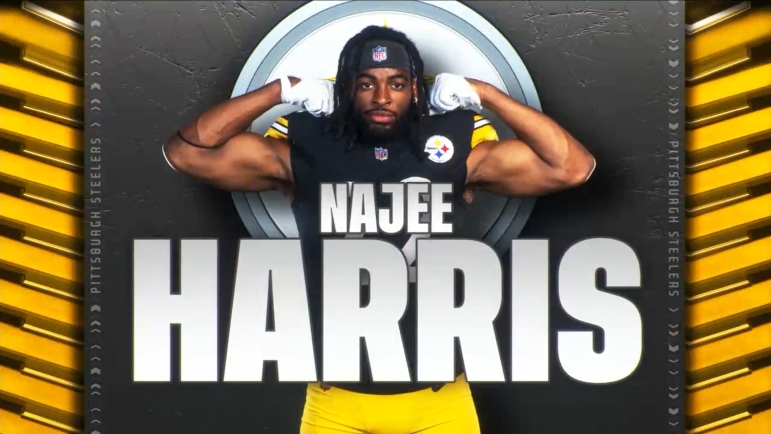The Pittsburgh Steelers wrapped up their annual mandatory minicamp on Thursday. After it ended, we found out that RB Najee Harris essentially didn’t do anything during the three-day session. Harris was even excused for one of the three days and also decided not to talk any to the media. Harris is obviously looking for a new contract this offseason and on Thursday afternoon, GM Omar Khan discussed the team’s former first-round draft pick and the decision that was made to not pick up the running back’s fifth-year option by the May deadline.
“It was a business decision that we had to make by, I think it was May 2nd,” Khan said of the fifth-year option decision on Harris on 93.7 The Fan. “But Najee is awesome to have around here. Love Najee as a player and a person. And just because we didn’t pick it up, it doesn’t exclude us from doing something with Najee for long term.
“You know, I’d love to say that Najee had a long career in Pittsburgh. He really represents us well on the field and off the field. But it was just one of those things that we had to make a decision on, and we just felt right now that was the right decision for everyone. But, I love Najee and would love to have him here long term.”
Based on what Khan said on Thursday, it’s hard to say whether the team will try in earnest to indeed sign Harris to a contract extension prior to the start of the 2024 regular season. Should, however, the Steelers indeed attempt to sign Harris to an extension in the next 80 or so days, one must think that such a contract will likely need to have a new money average greater than $8 million.
Currently, an $8 million new money average would result in Harris being tied with Baltimore Ravens RB Derrick Henry and Chicago Bears RB D’Andre Swift as the seventh-highest paid in the NFL at the position. Personally, I’m betting that Harris really thinks he should top that $8 million new money average.
Here’s something to watch for in the coming weeks as well when it comes to the running back market. It sounds like the New England Patriots are close to signing RB Rhamondre Stevenson to an extension. In fact, NFL contract expert Daniel Sailb believes Stevenson could get around a $9 million new money average. At the very least, it sounds like Stevenson is likely to crack the $8 million average mark. We’ll see, but nevertheless, it will be interesting to see the numbers of that deal if it gets done soon. Whatever those numbers are, you can probably bet Harris will want to top Stevenson’s new money average.
What could a Stevenson deal look like?
– he should aim to be the highest paid skill player on the Pats, surpassing 9 APY.
– he should look for incentive upside to account for a potentially resurgent 2024
– 3m+ in per games3 for 27m, 13m fully guaranteed. Incentives up to 33m. https://t.co/WWGR32T7oN
— Daniel Salib (@salibdaniel1) June 11, 2024
So, what if Stevenson ultimately slots in with a $9 million new money average? Well, he would then become the NFL’s seventh-highest paid running back behind Houston Texans RB Joe Mixon ($9.875 million). For Harris to be able to top both Mixon and Stevenson, he would need to have a new money average greater than that $9.875 million, obviously. That would make him the sixth-highest paid running back in the NFL behind Green Bay Packers RB Josh Jacobs ($12 million).
While I’m not saying such a deal ultimately happens for Harris that would just top Mixon’s new money average, it’s not totally out of the question just the same. In fact, it’s very doable on the Steelers’ end.
Below is what a two-year extension might could look like for Harris that would just barely best Mixon’s new money average. The hypothetical example deal I laid out below includes a $9 million signing bonus. Harris’ total cash flow for 2024 would be $10.2 million, which would be $7,760,802 more than he’s scheduled to make this season, which is $2,439,198.
In 2025 and 2026 in my example I have Harris getting a total of $12 million combined and split evenly over the final two seasons. While Harris’ total cash flow for the contract would be $22.2 million, his new money in the deal would be $19,760,802 and that would equate to a new money average of $9,880,401. That new money average would just barely top Mixon’s deal. Harris’ cash flow, however, would not be as strong year-by-year of that of Mixon, who will need to play in every game to hit his max income possible due to per game roster bonuses in his deal, which total $1.5 million. Even so, Harris’ new new money cash flow in his deal would top Mixon’s.
The way the contract example is set below, Harris’ 2024 cap charge would increase by just $1,760,802 and the Steelers could obviously handle that with relative ease. Harris’ cap charges in 2025 and 2026 would be an even $9 million, which are also very manageable. Harris could even be cut after the 2025 season with only a $3 million dead money charge to show for it. Realistically, Harris’ deal would be one-year for $10.2 million with two option years. Obviously, the hope would be that he plays at least the next two seasons, if not all three.
According to Over the Cap, the current projected franchise tag for a running back in 2025 is $13.005 million. In short, if Harris were to play under his current 2024 salary, and then somehow get the franchise tag in 2025, his two-year take, baring a new deal getting done next offseason, would be $15,444,198. My contract example has him earning $16.2 million through 2025 and while not fully guaranteed, it is virtually guaranteed barring a disastrous or unfortunate situation.
Once again, I am not necessarily condoning the example deal in this post. Instead, I am trying to provide a workable example that both sides maybe could live with and agree to.
In closing, keep an eye out for what ultimately happens with the Patriots and Stevenson in the coming weeks. Additionally, honestly ask yourself if you believe Harris would take a new money average of $8 million or less as part of an extension. Also ask yourself if you really believe the Steelers are interested in signing Harris to an extension this summer.
While I certainly don’t know how this summer will ultimately play out for Harris, contractually, it’s hard to imagine him signing an extension with a new money average less than $8 million. I think it’s also reasonable to expect him to want to top Mixon’s new money average, or at the very least, come damn close to it.
Okay, I am ready for all of you to grill this post in the comments below. Happy Friday and thank you for reading.









